« $5 pick shirt--Last Call! |
Main
| More mandolin chord melody virtuosity from Aaron Weinstein »
 July 25, 2010 | Sound to Earth--Weber Factory Tour July 25, 2010 | Sound to Earth--Weber Factory Tour

JazzMando roving reporter, Levy Littvay recently return from a personal tour of Sound to Earth, where they design and produce the world renown Weber mandolins. You're probably familiar with the story, the legendary (formerly) US built Flatiron mandolin company from Bozeman Montana was moved to Nashville, Tennessee when bought out by Gibson, soon after resulted in an exodus and return to western pastures in the shop of founder Bruce Weber and several of its world class luthiers who preferred not to leave their mountain nestled abodes, back to Belgrade, Montana in 1998. From humble beginnings to a major powerhouse in international mandolin family production barely more than a decade later, Weber craftsmen have earned a reputation as skilled custom builders, and have pioneered such widely established models as the Gallatin, Bridger, Bitterroot, and (personal favorite) Bighorn.
Levi weighs in...
 Tony Polecastro was extremely nice to show us around. (See on pics.) He walked us through the shop in a competitor's T-Shirt. When I asked about it, he said Bruce did help the Larrivee people get the finish right on their mando. Even (wife) Megan loved the tour. Tony Polecastro was extremely nice to show us around. (See on pics.) He walked us through the shop in a competitor's T-Shirt. When I asked about it, he said Bruce did help the Larrivee people get the finish right on their mando. Even (wife) Megan loved the tour.
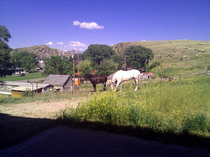 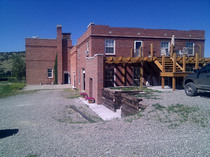
Bruce Weber's horses
The whole trip to Weber started by getting completely lost. Do not even try to use a GPS to get there. The shop is in an old school building in Logan, MT. The scenery around it is just stunning, mountains on all sides. The town itself has seen better times. It used to be a booming railroad town that got flooded one too many times.
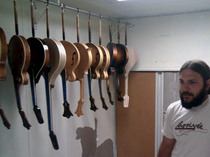 Tony said that lately they've been having a lot of limited runs, 5-10-20 instruments with a unique touch to them, and they sell well. He showed me a few beautiful tops that were carved from a single piece. One had a buffalo theme to it. He also said that they have been having trouble keeping the grade of the wood low on low-end instruments. Their suppliers have been so good to them they cannot get in low grade wood. Tony said that lately they've been having a lot of limited runs, 5-10-20 instruments with a unique touch to them, and they sell well. He showed me a few beautiful tops that were carved from a single piece. One had a buffalo theme to it. He also said that they have been having trouble keeping the grade of the wood low on low-end instruments. Their suppliers have been so good to them they cannot get in low grade wood.
I asked about the economy, he said that Weber did not have to let anyone go. It seemed scary for a while but things seem to be close to back to normal now.
 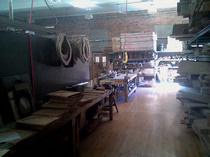
Click images for closeup
I played a few instruments, a new Gallatin F (recently redesigned to have a maple back and named after the river flowing by the shop, the one that flooded the town, and a beautiful blonde Yellowstone HT at the (local music store) Music Villa; both were phenomenal. Last time I played a Weber it was a few years back at Winfield (Kansas) where I picked at about a dozen of them, and I was NOT impressed. That was generally my impression up to that point of all Webers I played (a low end Gallatin A model at Acoustic Music Plus in Lincoln, NE and a Yellowstone and Gallatin F or two I twisted out of people's hand at Winfield). Something definitely changed. Music Villa had an old Fern in on consignment and it did not impress me as much as that Yellowstone HT.
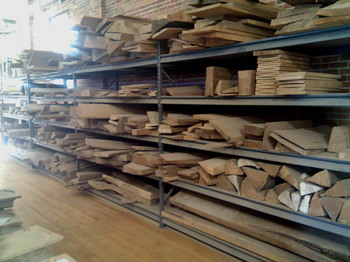 At the shop I played a Fern from last year that also did not impress me but I did pick up a Bridger F that was phenomenal. I always wanted to play a Bridger with the big D sound hole. It has a huge open sound that projects like no other mandolin. It is definitely a sound that would appeal to the JazzMando readership. Tony said that their classic series (A4 and F4 style oval holes) introduced a few years ago have been cannibalizing the Bridger sales which is too bad. The Bridger is a unique Weber style while the A4 and F4 are... you know. At the shop I played a Fern from last year that also did not impress me but I did pick up a Bridger F that was phenomenal. I always wanted to play a Bridger with the big D sound hole. It has a huge open sound that projects like no other mandolin. It is definitely a sound that would appeal to the JazzMando readership. Tony said that their classic series (A4 and F4 style oval holes) introduced a few years ago have been cannibalizing the Bridger sales which is too bad. The Bridger is a unique Weber style while the A4 and F4 are... you know.
I definitely see a Bridger big mando brother (probably an octave) in my future. I would probably opt for the A. There were some hidden treasures there as well. Bruce has two unfinished Gibson Bill Monroe models he took with him when he left Gibson.
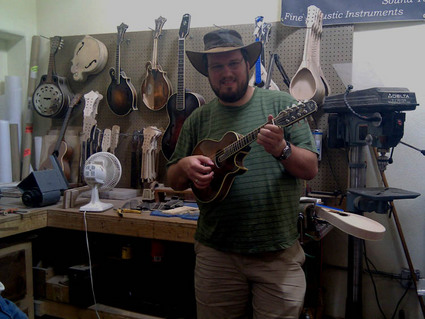
As for the mando pictured above. It is said to be a prototype that is collecting dust on their wall. It had a really interesting and unique sound. It reminded me of other guitar body mandos I played but with the big center hole it had an even more open sound. It was not loud. It definitely had a sound and feel that would appeal to the jazz crowd. Too bad it is just hanging on the wall.
I should mention that I use Weber Brekke bridges on my main mandolin, my mandola and my octave. And I love them.
Levy Littvay
JazzMando Staff Contributor
Website: Weber Fine Acoustic Instruments
Posted by Ted at July 25, 2010 5:55 AM

Disclaimer: In the 'Information Age' of the 21st Century,
any fool with a computer, a modem, and an idea can
become a self-professed 'expert." This site does not
come equipped with 'discernment.'
|



